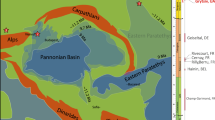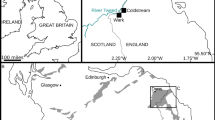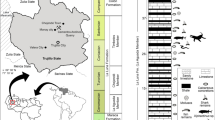Abstract
Salamanders are a model system for studying the rates and patterns of the evolution of new anatomical structures1,2,3,4. Recent discoveries of abundant Late Jurassic and Early Cretaceous salamanders are helping to address these issues5,6,7,8. Here we report the discovery of well-preserved Middle Jurassic salamanders from China, which constitutes the earliest known record of crown-group urodeles (living salamanders and their closest relatives). The new specimens are from the volcanic deposits of the Jiulongshan Formation (Bathonian)9,10,11,12,13, Inner Mongolia, China, and represent basal members of the Cryptobranchidae, a family that includes the endangered Asian giant salamander (Andrias) and the North American hellbender (Cryptobranchus). These fossils document a Mesozoic record of the Cryptobranchidae, predating the previous record of the group by some 100 million years14,15,16,17. This discovery provides evidence to support the hypothesis that the divergence of the Cryptobranchidae from the Hynobiidae had taken place in Asia before the Middle Jurassic period.
-
Amphibia Linnaeus, 1758
-
Lissamphibia Haeckel, 1866
-
Caudata Scopoli, 1777
-
Urodela Dumeril, 1806
-
Cryptobranchoidea Dunn, 1922
-
Cryptobranchidae Fitzinger, 1826
-
Chunerpeton tianyiensis gen. et sp. nov.
This is a preview of subscription content, access via your institution
Access options
Subscribe to this journal
Receive 51 print issues and online access
$199.00 per year
only $3.90 per issue
Buy this article
- Purchase on Springer Link
- Instant access to full article PDF
Prices may be subject to local taxes which are calculated during checkout




Similar content being viewed by others
References
Wake, D. B. & Larson, A. Multidimensional analysis of an evolving lineage. Science 238, 42–48 (1987)
Wake, D. B. Homoplasy: the result of natural selection or evidence of design limitations? Am. Nat. 138, 543–567 (1991)
Shubin, N., Wake, D. B. & Crawford, A. J. Morphological variation in the limbs of Taricha granulosa (Caudata: Salamandridae): evolutionary and phylogenetic implications. Evolution 49, 874–884 (1995)
Shubin, N. & Wake, D. B. Phylogeny, variation, and morphological integration. Am. Zool. 36, 51–60 (1996)
Gao, K.-Q. & Shubin, N. H. Late Jurassic salamanders from northern China. Nature 410, 574–577 (2001)
Gao, K., Cheng, Z. & Xu, X. First report of Mesozoic urodeles from China. Geol. China 248, 40–41 (1998)
Wang, Y. A new salamander (Amphibia: Caudata) from the Early Cretaceous Jehol Biota. Vert. PalAsiat. 38, 100–103 (2000)
Dong, Z. & Wang, Y. A new urodele (Liaoxitriton zhongjiani gen. et sp. nov.) from the Early Cretaceous of western Liaoning Province, China. Vert. PalAsiat. 36, 159–172 (1998)
Wang, S. et al. Stratigraphical Lexicon of China: The Jurassic System (Geological Publishing House, Beijing, 2000)
Krzemiski, W. & Ren, D. Praemacrochile chinensis n. sp. from the Middle Jurassic of China (Diptera: Tanyderidae). Pol. Pis. Entomol. 71, 127–129 (2002)
Ren, D. & Oswald, J. D. A new genus of kalligrammatid lacewings from the Middle Jurassic of China (Neuroptera: Kalligrammatidae). Stuttgart. Beit. Nat. B 33, 1–8 (2002)
Ji, Q. & Yuan, C. Discovery of two kinds of protofeathered pterosaurs in the Mesozoic Daohugou Biota in the Ningcheng region and its stratigraphic and biologic significances. Geol. Rev. 48, 221–224 (2002)
Ren, D. et al. On the biostratigraphy of the Jurassic fossil beds at Daohugou near Ningcheng, Inner Mongolia. Geol. Bull. China 21, 584–591 (2002)
Naylor, B. G. Cryptobranchid salamanders from the Paleocene and Miocene of Saskatchewan. Copeia 1981, 76–86 (1981)
Estes, R. Handbuch der Paläoherpetologie Teil 2 Gymnophiona, Caudata (Gustav Fischer, Stuttgart, 1981)
Gubin, Y. M. Paleocene salamanders from Southern Mongolia. Paleontol. J. 1991, 91–102 (1991)
Harland, B. W. et al. A Geologic Time Scale 1989 (Cambridge Univ. Press, Cambridge, 1990)
Evans, S. E. & Milner, A. R. A metamorphosed salamander from the Early Cretaceous of Las Hoyas, Spain. Phil. Trans. R. Soc. Lond. B 351, 627–646 (1996)
Milner, A. R. in Amphibian Biology Vol. 4 (eds Heatwole, H. & Carroll, R. L.) 1412–1444 (Surrey Beatty, Chipping Norton, Australia, 2000)
Milner, A. R. in Evolution, Time and Space: The Emergence of the Biosphere (eds Sims, R. W., Price, J. H. & Whalley, P. E. S.) 431–468 (Academic, London, 1983)
Duellman, W. E. & Trueb, L. Biology of Amphibians (McGraw-Hill, New York, 1986)
Larson, A. & Dimmick, W. W. in Amphibian Relationships: Phylogenetic Analysis of Morphology and Molecules (eds Cannatella, D. & Hillis, D.). Herpetol. Monogr. 7, 77–93 (1993).
Venczel, M. & Hír, J. in Abstracts of the Third World Congress of Herpetology (eds Rocek, Z. & Hart, S.) 218–219, (Third World Congress of Herpetology, Prague, 1997)
Ivachnenko, M. F. Urodelans from the Triassic and Jurassic of Soviet Central Asia. Paleontol. J. 12, 362–368 (1978)
Nessov, L. A. Late Mesozoic amphibians and lizards of Soviet Middle Asia. Acta Zool. Cracov. 31, 475–486 (1988)
Nessov, L. A., Fedorov, P. V., Potanov, D. O. & Golovyeva, L. S. The structure of the skulls of caudate amphibians collected from the Jurassic of Kirgizstan and the Cretaceous of Uzbekistan. Vest. Sankt-Peters. Univ. Geol. 7, 3–11 (1996)
Evans, S. E., Milner, A. R. & Mussett, F. The earliest known salamanders (Amphibia: Caudata): A record from the Middle Jurassic of England. Geobios 21, 539–552 (1988)
Wake, D. B., Roth, G. & Wake, M. H. On the problem of stasis in organismal evolution. J. Theor. Biol. 101, 211–224 (1983)
Scotese, C. R. Atlas of Earth History Vol. 1 Paleogeography (Paleomap Project, Arlington, Texas, 2001)
Acknowledgements
We thank Q. Ji for providing access to the holotype specimen. M. Ellison did the photographs of the holotype; K. Monoyios performed the drawings. This research was supported by the National Science Foundation, the National Natural Science Foundation of China (K-Q.G.), and a grant from the John Simon Guggenheim Memorial Foundation (N.S.).
Author information
Authors and Affiliations
Corresponding author
Ethics declarations
Competing interests
The authors declare that they have no competing financial interests.
Rights and permissions
About this article
Cite this article
Gao, KQ., Shubin, N. Earliest known crown-group salamanders. Nature 422, 424–428 (2003). https://doi.org/10.1038/nature01491
Received:
Accepted:
Issue Date:
DOI: https://doi.org/10.1038/nature01491
This article is cited by
-
Inter-amphibian predation in the Early Cretaceous of China
Scientific Reports (2019)
-
Proteomic analysis of eleven tissues in the Chinese giant salamander (Andrias davidianus)
Scientific Reports (2019)
-
High-throughput sequencing reveals the gut and lung prokaryotic community profiles of the Chinese giant salamander (Andrias davidianus)
Molecular Biology Reports (2019)
-
Identification of critical sex-biased genes in Andrias davidianus by de novo transcriptome
Molecular Genetics and Genomics (2019)
-
RNA-seq analysis provides insight into molecular adaptations of Andrias davidianus
Development Genes and Evolution (2019)
Comments
By submitting a comment you agree to abide by our Terms and Community Guidelines. If you find something abusive or that does not comply with our terms or guidelines please flag it as inappropriate.



